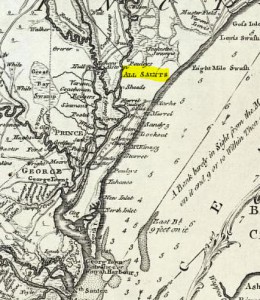S.C. Encyclopedia | Established on March 16, 1778, All Saints Parish comprised the Waccamaw Neck of what came to be Horry and Georgetown Counties. In 1721 the peninsula became part of Prince George Winyah Parish, but separated from the rest of the parish by the Waccamaw River, it remained isolated and sparsely settled for decades. Because they could only reach the parish church by water, which was “very hazardous in blowing weather,” the inhabitants of Waccamaw Neck constructed a chapel of ease on Pawleys Island circa 1736.
 On May 23, 1767, the Commons House of Assembly created All Saints Parish, granted it two representatives, and the chapel became the new parish church. King George III had recently prohibited the enlargement of colonial legislatures, however, and three years later he disallowed the parish. Shortly after South Carolina declared its independence from Britain, All Saints was reestablished in 1778.
On May 23, 1767, the Commons House of Assembly created All Saints Parish, granted it two representatives, and the chapel became the new parish church. King George III had recently prohibited the enlargement of colonial legislatures, however, and three years later he disallowed the parish. Shortly after South Carolina declared its independence from Britain, All Saints was reestablished in 1778.
With the introduction of tidal rice culture in the mid-eighteenth century, the Waccamaw River, which had so long been a barrier to the development of the Neck, quickly became its greatest asset. Plantations sprang up along its banks, and by 1810 African slaves made up nearly ninety percent of the parish population.
On the eve of the Civil War, per capita wealth for the free residents of All Saints was among the highest in the nation. With 1,092 slaves, Joshua John Ward, a rice planter and warden of All Saints Church, was one of the largest slaveholders in the entire South. With the abolition of the parish system in 1865, All Saints Parish became part of Horry and Georgetown Counties.
– Excerpted from the entry by Matthew A. Lockhart. To read more about this or 2,000 other entries about South Carolina, check out The South Carolina Encyclopedia by USC Press. (Information used by permission.)



 We Can Do Better, South Carolina!
We Can Do Better, South Carolina!
























